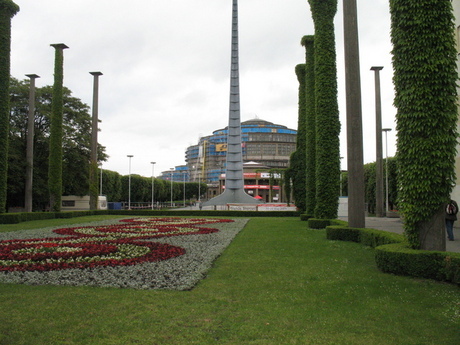Iglica
Iglica ("the spire" or "needle") is a needle-like monument in Wrocław, Poland. It was built in 1948 and was 106 meters tall. Today, after renovation, the top ten meters have been removed and it is now 96 meters tall.
This structure was constructed by Polish Communists for an exhibition to celebrate the regaining control over the "Regained Territories" after Second World War. The Iglica is located very close to the Centennial Hall, the spectacular building constructed by Germans in 1912 and its purpose was to move the centre of attention from the Centennial Hall to Iglica. Originally topped by a spinning contraption of mirrors, creating an "umbrella of light" at night, this was struck by lightning within a day of completion, and prior to the official opening. The remnants of this damaged structure were apparently removed by two climbing enthusiasts at no cost, the military failing to be able to tackle the task.
This iconic 96 metre tall steel spire was erected on the Centennial Hall exhibition grounds in 1948 as part of the propagandic 'Recovered Territories Exhibition.' Meant to symbolise the soaring achievements of the country's newly acquired western territories since they were 'returned' to Communist Poland, like many of the Party's ideas, this one quickly went wrong. Originally 106 metres, Iglica's peak was adorned with a spinning contraption of mirrors which would create a dazzling 'umbrella of light' at night. The apparatus was ominously struck by lightning only hours after completion with much of it crashing to the ground in dazzling catastrophe. The remaining dangling bits posed quite a hazard to the expected thousands who would attend the exhibition. To the rescue came two college students who were part of a climbing club and volunteered to dismantle the top of the structure for free after the military proved unable to sort the situation due to the inclimate weather. Scaling the Iglica took 24 hours and 15 minutes, dismantling it another six, but the boys succeeded in becoming heroes of the enormous media spectacle. In 1964, the spire was reduced by 10 metres for safety reasons. During martial law, another daredevil climbed the tower and attached a Solidarity flag to its zenith. Today the ugly ribbed structure continues to stand outside Hala Stulecia and is probably one of the tallest pieces of useless bolted metal in the world. To get to Centennial Hall Complex take trams 1, 2, 4 or 10 east from the city centre.
In 2007, Iglica turned into Europe’s highest Christmas tree. At the opening of the Beijing Olympic Games, a group of members from association “Young Wroclaw”hanged the Tibetan flag, in solidarity with people from Tibet persecuted by Chinese authorities.
You can find the second, much smaller Iglica set in the central of Plac Solny (Salt Square), just next to market square. It was placed there in 1996.




